
|
Sale 78
January Pre-Long Beach Sale 17.5% BP
| Lot |
Photo |
Description |
Realized |
Lot 1856 |
 |
1850. PCGS graded MS-62. An outstanding needle sharp strike exhibiting full definition within each star and denticle. Liberty's head appears in high relief as well as the other raised devices. The shimmering mint luster is intense and appears semi-reflective. Delicate golden overtones further add to its appeal. Always popular as the first year of production of the Double Eagle.
The 1850 Double Eagle is readily available in circulated grades, typically Very Fine or Extremely Fine, with occasional About Uncirculated examples on the market. Both the 1850 and 1850-O seem to have circulated widely. In any grade the 1850 has always been in great demand. A few dozen Mint State pieces are known.
The dies must have been fresh when this handsome piece was made. The 1850 Double Eagle is particularly significant as the first year of issue of this denomination. Such pieces quickly went into circulation where they developed wear and got thoroughly knocked about, being made of soft metal and heavy as the dickens. Today even at the basic MS60 level the 1850 is scarce, and in choice Mint State 62, as here, it is very rare. The date was too early to be found among the recovered treasure ships, and accordingly a piece such as this is apt to have survived by random chance. Pop 36; 9 finer, 1 in 62+, 7 in 63, 1 in 64 (PCGS # 8902) .
Historic Notes: One of the consequences of the discoveries of gold in California was a sizeable increase in gold bullion coming to the Philadelphia Mint for coinage. Authorities felt that large-scale domestic or international transactions payable in gold should be made in more compact form than Eagles or smaller denominations. Accordingly, Rep. James Iver McKay was persuaded to introduce an amendment to his Gold Dollar bill, Feb. 1849, which would authorize coinage also of $20s, to be called Double Eagles. These were to weigh 516 grains = 33.436 grams, a little over a troy ounce each, and be roughly comparable in value to several Latin American denominations.
About Jan. 26, 1850, the first production coins appeared. Many were saved as first of their kind; other mint state specimens came from the 132-coin Baltimore hoard, mostly thoroughly bagmarked. All double eagles, 1850-58, are from a master die in which LIB was corrected from LLI: a condition publicized by Carl W. A. Carlson, "NY Coll.," p. 19.
No design changes occurred on reverse, which is in low enough relief that even Mint Director Peale found no fault with it. Its double scroll was designer Longacre's deliberate allusion to the denomination of Double Eagle, its glory (stars in rays) recalled the Great Seal of the United States.
Estimated Value $20,000 - 22,000.
The Del Valle Collection.
View details and enlarged photos
Check results on similar lots
| Realized
$34,075 |
Lot 1857 |
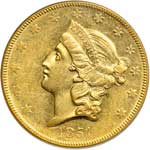 |
1851-O. PCGS graded AU-55. Lots of original mint luster rests with the protected areas of the devices. The 1851-O double eagle is fairly scarce in the context of general American numismatics, but sufficient numbers exist that examples appear on the market from time to time. Of the first three dates of New Orleans coins of this denomination, the 1851-O is slightly less scarce than 1850-O and 1852-O. Also, as the second year of the double eagle, and accordingly the second New Orleans issue, the variety is always in strong demand due to its historic associations (see below). Most specimens are in the Very Fine to Extremely Fine grade range, typically bagmarked, and, indeed, this has been about par for Type 1 double eagles even in the greatest collections. Choice About Uncirculated pieces like this are especially scarce. Pop 33; 20 finer, 10 in 58, 1 in 60, 1 in 61, 8 in 62. (PCGS # 8905) .
Historic New Orleans: On a voyage to New Orleans down the Mississippi in 1857, the steamboat pilot, Horace E. Bixby, inspired his passenger, Samuel L. Clemens (later calling himself "Mark Twain") to pursue a career as a steamboat pilot like Bixby himself; it was a richly rewarding occupation with wages set at $250 per month, equivalent to $155,000 a year today. Who can say that a pilot might even have been paid in locally circulating New Orleans minted $20 gold pieces including this one! It is a fair possibility.
A steamboat pilot needed a vast knowledge of the ever-changing river to be able to stop at any of the hundreds of ports and wood-lots along the river banks on the passage to America�s busiest port of the day, New Orleans. The 22-year-old future author meticulously began to study 2,000 miles (3,200 km) of the Mississippi for more than two years before he received his steamboat pilot license in 1859. While training, Clemens convinced his younger brother Henry to work with him. Henry was killed on June 21, 1858, when the steamboat he was working on, the Pennsylvania, exploded. Twain had foreseen this death in a detailed dream a month earlier, which inspired an interest in parapsychology. Twain was guilt-stricken over his brother's death and held himself responsible for the rest of his life. However, he continued to work on the river (no doubt getting paid in O-mintmarked gold coins!), and served as a river pilot until the Civil War broke out in 1861, when traffic along the Mississippi was curtailed.
Estimated Value $5,000 - 6,000.
View details and enlarged photos
Check results on similar lots
| Realized
$12,338 |
Lot 1858 |
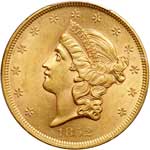 |
1852. PCGS graded MS-61. Very frosty with a hint of gold tone. Well struck. Double Eagle strikes began at the Philadelphia Mint in 1850. They continued exclusively at that facility until the San Francisco Mint opened in 1854. As the chosen and most commonsense means to handle the large, heavy coins, Philadelphia took on the burden of the lion's share of the work; the first four years of the regular mintage recorded a million pieces struck annually, and for the 1851 and 1852 issues, there mintage went into the multiple millions.
Yet availability in high grades is today strictly limited. The Double Eagle denomination was meant to circulate, and circulate it did. Today, most 1852s are in grades such from Very Fine to Extremely Fine, with occasional examples in higher condition coming on the market.
This Mint State 61 survivor is one of the few in Uncirculated recorded in the grading service databases; a collector would be thrilled to own it. Only a few small marks and hairlines visible, enough to preclude a finer designation; otherwise soft satiny luster extends pretty much everywhere. With eye appeal commensurate with its satiny allure. Easily a Philadelphia $20 that blows its own horn, so to speak, in terms of preservation seldom seen save on San Francisco shipwreck pieces in the mid-1850s to 1860s. Pop 29; 47 finer, 33 in 62, 10 in 63, 4 in 65. (PCGS # 8906) .
Estimated Value $6,000 - 7,000.
View details and enlarged photos
Check results on similar lots
| Realized
$11,456 |
Lot 1859 |
 |
1854-S. PCGS graded MS-62. A lovely BU example exhibiting pinkish-golden frosty mint luster. Slightly matte-like. A tell-tale sign that this example was from the sunken treasure recovered near Anacapa Island off the west coast of central California.
Artifacts from the sunken steamer S.S. Yankee Blade are said to have been salvaged by divers around 1977, and at least 200 to 250 specimens of 1854-S gold $20 coins are believe to have been found (although no accounts of exact figures have been released). As is often true of treasure salvage situations, little factual information is forthcoming; often the more publicity given to a treasure find, the more claimants appear to seek a share. Pop 23; 23 finer, 17 in 63, 4 in 64, 2 in 65 (PCGS # 8913) .
Wreck of the Yankee Blade: The SS Yankee Blade, launched in 1853, was in the service of the Steamship Co. in 1854. On October 1 she was on a run from San Francisco south to Panama, carrying about 900 passengers and crew and an unknown amount of gold, but including about $152,000 in coins consigned by the banking house of Page, Bacon and Co. In heavy fog Captain Henry T. Randall, believing he was in deep water far at sea, proceeded at full speed ahead, trying to establish a speed record -- certain to be beneficial in advertising.
The captain was mistaken. It turned out the steamer was amid the rockbound Channel Islands, off the coast of Santa Barbara, California. The ship smashed onto a rock, and was stranded at an acute angle. In time, she sank, but not before most passengers and crew had escaped. In the ensuing confusion, an estimated 17 to 50 passengers lost their lives.
As to what became of the gold coins aboard, some were recovered soon after the disaster, in circumstances shrouded in mystery. Perhaps other coins were found later, over a long period of time. In 1948 the hull was relocated, and various divers visited the wreck. Circa 1977, extensive recoveries were made, with an estimated 200 to 500 1854-S Double Eagles later appearing on the market. All showed microscopic granularity, possibly from the action of sea-bottom sand, and all had die cracks on the reverse from the die used to strike them. Little in the way of hard facts had ever reached print.
Estimated Value $15,000 - 17,000.
The Del Valle Collection.
View details and enlarged photos
Check results on similar lots
| Realized
$38,775 |
Lot 1860 |
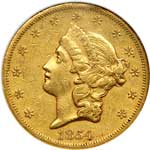 |
1854-S. NGC graded EF-45. Beautiful original "dirty old gold" surface. Or more politely worded, true antique toning surpassing so many others that have been dipped or scrubbed. Struck the opening year of the San Francisco Mint from California Gold Rush bullion deposits. A magical year in American numismatics. The aura one receives from one of these '54-S Twenties is nothing to sniff at! Expect strong competition for it (PCGS # 8913) .
Note: In 1854, most of this branch mint's scanty supply of parting acids for refining gold deposits into .900 Fine alloy for coins had to be reserved for making Double Eagles; coinage of Half Eagles and Quarter Eagles was suspended after small initial deliveries.
Estimated Value $3,000 - 3,300.
View details and enlarged photos
Check results on similar lots
| Realized
$8,225 |
Lot 1861 |
 |
1856-S S.S Central America. PCGS graded AU-58. 17J Split Serif. SSAC-5882. In a special gold tag PCGS holder. An intensely lustrous example. Could easily be mistaken for a Mint State 61 or 62 with this amount of fresh, satiny luster. There were far more 1857-S double eagles found in the sunken wreck of the SS Central America than coins dated 1856-S. And as with the few other �56-S Twenties from this famous treasure trove, the devices were struck smack on the dot at the required force by the dies, leaving all design elements plain and clear-cut. Not one iota of weakness as found on some examples from the same 1850s decade parading around in the same numerical grade. Worth considering and a coin that we expect will realize well in advance of a more typical AU58 specimen.
The SS Central America, sometimes called the Ship of Gold, was a 280-foot sidewheel steamer that operated between Central America and the eastern seaboard of the United States during the 1850s. She was originally named the SS George Law. The ship sank in a hurricane in September 1857, along with 400 passengers and crew and 30,000 pounds of gold, contributing to the Panic of 1857.
Estimated Value $3,000 - 3,200.
View details and enlarged photos
| Realized
$7,344 |
Lot 1862 |
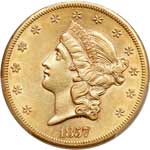 |
1857-S. PCGS graded AU-55. Mostly untoned. A lustrous, well struck example from the early San Francisco Mint. Much of the bullion deposited for coinage during the California Gold Rush went into $20 gold pieces as the handiest size for bulk transport. That much of this Mint's production went to East Coast banking centers is attested to by the famous Panic of 1857. A banking panic raged in New York, Philadelphia, Boston and other money centers. When the SS Central America side-wheel steamship sank off the coast of the Carolinas with its cargo of much needed 1857-S $20 gold pieces that year, the Panic intensified. The gold was urgently needed to stem the ongoing bank runs by depositors (PCGS # 8922) .
Estimated Value $2,100 - 2,200.
View details and enlarged photos
Check results on similar lots
| Realized
$3,408 |
Lot 1863 |
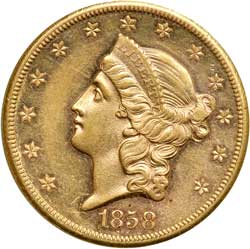 |
1858-S. Numistrust graded MS-63 Prooflike. Well struck with blazing semi-reflective surfaces. We note a moderate scratch from the cheek running down to Liberty's neck. This could have been mint caused. Our grade is MS60. A very appealing example. San Francisco Mint started production in 1854 and continued at a relatively high level into the 1860s and beyond striking Double Eagles from the abundant bullion being dug out of California's gold fields. This is a handsome, well made example with semi-reflective fields. The devices have a light sheen of frost on them from the dies (PCGS # 8925) .
Estimated Value $5,000 - 5,500.
View details and enlarged photos
Check results on similar lots
| Realized
$4,994 |
Lot 1864 |
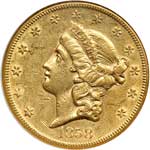 |
1858-S. NGC graded AU-53. Normal allotment of contact marks with enough mint luster still intact to easily justify the grade. A pleasing untoned example (PCGS # 8925) .
Estimated Value $2,500 - 2,750.
View details and enlarged photos
Check results on similar lots
| Realized
$3,055 |
Lot 1865 |
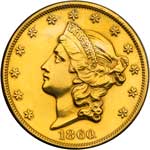 |
1860. Sharpness of AU however polished to look like a proof coin.
Estimated Value $1,300 - 1,350.
View details and enlarged photos
| Realized
$1,469 |
Lot 1866 |
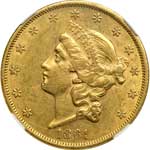 |
1861. NGC graded AU-53. Pleasing old-gold color. Frosty mint luster is delivers penetrating beauty and originality on this handsome coin. Normal detail on all devices is typical for Type 1 $20 gold issues; however, with present 1861 we see a wonderful exception in which broad regions of crisp strike can be found on the stars and main devices. A remarkable coin (PCGS # 8932) .
Estimated Value $2,000 - 2,200.
View details and enlarged photos
Check results on similar lots
| Realized
$2,644 |
|
|